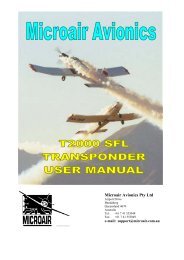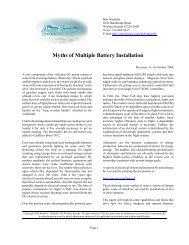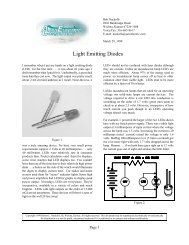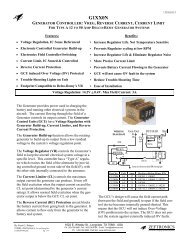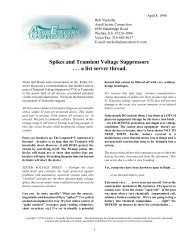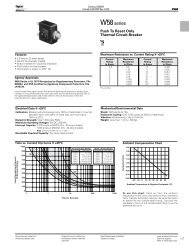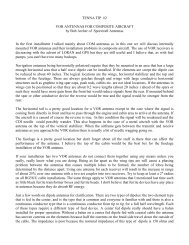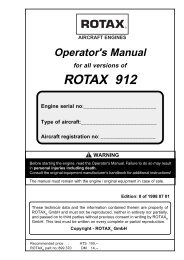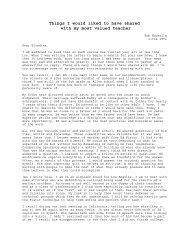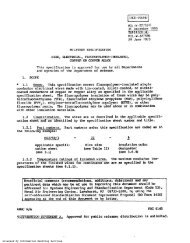Aircraft Wiring for Smart People - AeroElectric Connection
Aircraft Wiring for Smart People - AeroElectric Connection
Aircraft Wiring for Smart People - AeroElectric Connection
You also want an ePaper? Increase the reach of your titles
YUMPU automatically turns print PDFs into web optimized ePapers that Google loves.
But that isn’t what you suggested earlier. Understanding of simpleideassuggests that the Seawind's electrical system was poorlycrafted. If it's an OBAM aircraft and hasn't been combed out <strong>for</strong>nuisance tripping due to undersized fuses, breakers and wires, it’snobody's fault but the owner. If it’s a certified ship and suffersfrom nuisance tripping, then we KNOW why the owner puts up with it.It’s too expensive to fix.The intent of the fuse is to protect the wire, which can probablyhandle 10 or more amps. My question is why are we using a 3A fuse tostart with? Why not use a 10A fuse, and have it blow when we have anactual fault? That's the intent. He even says its a good idea to specAlternator breakers this way, as if they are the only devices that drawmore current cold than hot. I work with CCFL backlit LCDs that have thesame issue. I still submit it's a good idea, and is common practiceelsewhere. We just disagree.I’m confused. What do we disagree on? I took issue with yourstatement that a breaker will open in 20 to 30 minutes when loadedto 80 percent of it’s rated value - a statement that argues withengineering data from the circuit breaker and fuse manufacturer. Nowyou seem to have shifted to agreement with the notion thatper<strong>for</strong>mance of accessories over the entire expected operating rangeis a good idea so that you don’t get blind-sided on breaker and fusesizing. You’ve brushed aside the questioned statement. I don’t seethat we disagree on this point at all now.Sorry to start an argument, but Bob is solidly DEAD WRONG on his hackof my 24 volt discussion. Most avionics (electronics, not light bulbs)will run on 10 to 32 volts.Didn’t say that. Lots of modern avionics are fitted with switch-modepower supplies designed to per<strong>for</strong>m in either a 14 to 28 voltaircraft without throwing any switches inside the radio or rewiringthe power plug. I would argue with the term “most” because mostdevices are built <strong>for</strong> the certified market. While per<strong>for</strong>mance downto a stead state voltage of 10.5 volts is cool and within easy reachof the current technology, it’s not common amongst the wholecommunity of suppliers to the aircraft industry. Further, there’stons of “old” stuff finding its way into the OBAM aircraft market.You made a blanket statement 24-volt batteries are preferred <strong>for</strong>aircraft, period. I believe the supporting thesis was that thisgives you more headroom during cranking IF the accessory begging <strong>for</strong>power has this modern 10-32 volt input power capability.A 12 volt battery has a lot more energy left at 11 volts than a 24 voltbattery."A lot" is non-quantified. Yes, the ENERGY contained in a 12 voltbattery discharged to 11 volts is greater than <strong>for</strong> a 24 volt batterydischarged to 11 volts . . . but we're comparing less than 5% versuszero percent. In fact, a 24 volt battery discharged to 11 volts mayalready be in cell reversal and balancing on the edge of the scrapheap. Do I understand correctly that the original thesis was thatyou’re less likely to have a disrupting effect on 10-32 voltavionics during cranking if you used a 24-volt system?5 of 14Response_2 26 Sept 2004Bob Nuckolls
Letting the per<strong>for</strong>mance characteristics of one or two radios orother avionics drive the system voltage selection process ignoresother aspects of system per<strong>for</strong>mance requirements in airplanes thatthe certified side of the house understands and signs up <strong>for</strong> . . .which includes brown-outs and interruptions down to zero volts. Moreon this later.Look at the curves. A 24 volt battery at 11 volts is nearly destroyed.A 12 volt battery at 11 volts is only partially discharged.Okay, here's a curve. Check out page 7 ofhttp://www.enersysreservepower.com/documents/US_GPL_SG_001_0303.pdfTake a look at the family of discharge curves. For all temperatures,by the time voltage drops to 11.0 volts (1.83 volts per cell) in a12v battery the curves are all pointed decidedly south. Further,this inflection on the curve is at the END of the discharge cycle.Yes, a 24 volt battery down to 11 volts is down to 0.9 volts percell. The phrase "partially discharged" is inappropriate whenreferring to energy left doing any useful work.There is more room <strong>for</strong> voltage sag, and you just do not have the dropouts associated with 12 volt start systems with 24 volt start systems.He can wave his Aeroelectric wand all he wants, but the facts are whatthey are and installed airplanes bear this out.Are we talking about two different things? Effects during startingare an entirely separate case from discussing ENERGY remaining at11.0 volts . . . I can show you batteries with very low capacitiesbut exceedingly low internal impedance. Voltage sag during crankingis driven by battery, wiring and switch-gear impedance. Therelationship to the gross size (capacity) of the battery and voltagedrop during cranking is only loosely connected.He's also DEAD WRONG on the shield comment and cop-out on p. 21.Connecting both ends of a shield is a bad idea, it makes the shield notwork. If the shield is required <strong>for</strong> a return lead, that's anotherstory, and is not what is being discussed. Bob's an EE and he knowsthat. The PS Engineering guys and all the audio engineers I've everworked with do it this way. Again, we disagree.You cited Kirchoff's law in your text, let's review thework of Mr. Faraday. He describes the effects of electro-staticcoupling between conductors and the effects of "Faradayshields" in breaking that effect. It matters not whethera shield is totally independent (connected one-end only)or part of the system's designed in ground-returns (connectedboth ends).Bob persists in ignoring what is written, . . .Please cite any facts in evidence . . . anything that I’ve ignored.I’d be pleased to go look it up.6 of 14Response_2 26 Sept 2004Bob Nuckolls
elow limits. Now, could I use that coating as a chassis ground <strong>for</strong>the conduction of power? No way . . the sheet resistance is too highand further, I can’t fabricate a high current, gas-tight bond to it.VHF antennas are tuned. They have low impedance, high currentmatching points intended to drive coax at low SWR and low losses.“Ohmic” joints of very low resistance are much desired and soughtafter. This is a hallmark of every antenna design and constructiontext since Marconi was knee high to a spark gap. ADF antennas onairplanes are low current, sub-fractional wavelength, e-fielddevices. Their operating modes and installation requirements arestrikingly different from tuned antennas used at VHF and above.The most positive thing I read was where he said "I can deduce no bigargument against this philosophy". He was clearly looking <strong>for</strong> a bigargument at every turn, but blessedly didn't find one there.I’m pleased that you feel blessed but the statement was madein support of the notion that an airplane COULD be totally wiredwith 10A circuit protection and 16AWG wire. I perceive no safetyissues here. I do question the cost of fabrication and ownershipvalue. I am not looking <strong>for</strong> anything except to assist my readers inunderstanding the simple-ideas which govern the operatingcharacteristics of components and materials available <strong>for</strong> buildingtheir airplanes. I offered specific arguments <strong>for</strong> many statementsyou made. I'll welcome your participation on the <strong>AeroElectric</strong>-Listor any other venue to straighten me out.I put off publishing guidelines on wiring even though I've seen so muchtruly atrocious work, much of it per Bob's book, <strong>for</strong> this very reason:it is absolutely not my desire to engage in a public flame war over whomakes the best shrink tube and why it should or shouldn't take a threeman engineering team to wire a radio. There's far more important thingsto do than argue over how to do things that can be done multiple waysand still be done well.lots of rhetoric, citation of facts not in evidence and not onespecific point to be debated. Please take any simple-idea I’veoffered and make my day, show me where it’s wrong. When you foundsomething malfunctioning in someone’s airplane and they claimed tohave consulted the <strong>AeroElectric</strong> <strong>Connection</strong>, please cite the page andparagraph of the ‘<strong>Connection</strong> responsible <strong>for</strong> so seriously misleadingthe builder. Was the difficulty because a technique suggested inthe ‘<strong>Connection</strong> was in error or was it because the builder did notunderstand or properly install it?The <strong>AeroElectric</strong>-List, the <strong>AeroElectric</strong> <strong>Connection</strong> and the websitehave always been open <strong>for</strong>ums where folks in quest of knowledge willbe welcome. Folks with additional and/or alternative views supportedby simple-ideas are equally welcome. If there are errors, I’d liketo know about them. I’m disappointed that you aspire to be a teacherwhile allowing a publication of erroneous in<strong>for</strong>mation to gounchallenged. How long have you known about any errors in the‘<strong>Connection</strong> and not made me aware of them?8 of 14Response_2 26 Sept 2004Bob Nuckolls
If I were truly mean-spirited, I'd publish a critique of his book(which is emminently critiqueable), but who cares?I care and so do my readers. So I’m mean spirited too? Give me abreak Greg, we’ve never met and I’ll bet you haven’t read tenparagraphs of what I’ve offered on the List and elsewhere <strong>for</strong> over15 years. Please don't take on the whole book. Take it one simpleideaat a time. If you don’t have a copy, tell me and I’ll mail youone at no charge.It's not productive to discuss the invention of houses or tool shedsbe<strong>for</strong>e we understand the boards, bricks, screws, nails and hammersavailable to the task. I’ve tried to be very specific in the reviewof your writings and to support my own words with simple-ideas. I’llrequest and expect no more and no less from you sir.There's enough info out there <strong>for</strong> anyone who's interested to get a goodhandle on what to do, and how to do it.We are awash in “info”. There are terabytes of in<strong>for</strong>mation on theInternet alone. However, the proportion of in<strong>for</strong>mation supported byhistorical fact, simple-ideas in physics and lucid critical reviewis the proverbial grain-of-sand-in-the-ocean. It’s our duty asteachers to find those grains and share how they fit into practical,failure tolerant, low cost of ownership designs with anyone who isinterested. This is the hallmark of what the OBAM aircraftcommunity has come to represent.I just put another point on the graph, where one really needed to be.I have often referred to “simple-ideas” . . . basic truths whereintheir principal, value and application are easily understood. Onesuch simple-idea is liberty. A condition that allows one to gothrough life free of <strong>for</strong>ce or fraud against their person orproperty. Another is honor. The honorable individual goes out oftheir way to protect the liberty of others. A third simple-idea I’lloffer concerns that noble profession called “teacher.” It is NOT themission of a teacher to convince anyone of anything. The art ofpersuasion is <strong>for</strong> preachers, politicians and door-to-door salesmen.Teachers are disseminators of simple-ideas supported by historicalfacts and illustrations of how ideas may be assembled in useful waysi.e., understanding.Teachers can be inventors too but it’s really up to students to siftthrough the big box of Tinker Toys, Legos, and Erector Set parts toassemble their own inventions. If their teachers are true to theprofession, then the student’s path to success is made easier andmore productive. Best yet, they too become teachers by demonstratingand sharing their successes.I embrace these simple-ideas. In so doing, I’m not permitted to lieto you. I’m not permitted to write words intended to cause you harmor discom<strong>for</strong>t. I am obligated to defend you when others directdishonorable behavior at you. As a teacher, I have a duty tounderstand anything you or anyone else offers as a simple-idea andeither support it or spotlight its fallacies. If everyone embraced9 of 14Response_2 26 Sept 2004Bob Nuckolls
these simple-ideas, the Challenger wouldn’t have blown up, theTitantic wouldn’t have gone down and TWA800 wouldn’t have blownapart. Countless other disasters in history are the product ofindividual acts of fraud against innocent individuals.I’ll invite you to engage in a published discussion of the simpleideasunder consideration. I’ll be posting this and other documentsdirected to this study on my website. I will encourage you toparticipate in the discussions and to post it to your website aswell.Please accept my invitation to participate in any of my weekendseminars free of charge. You don’t even need a reservation. Justshow up. We’ll make a place <strong>for</strong> you right on the front row.In the quest <strong>for</strong> uncovering simple-ideas, I’ve crafted the followingquestionnaire based on your original publication. I’ve studiouslyavoided pejorative verbiage in what I hope is viewed as a quest <strong>for</strong>understanding and enlightenment. Only after the questions are alldeduced and answered can we both move <strong>for</strong>ward as competent andhonorable teachers.“This isn’t about all the possible ways to accomplish the job – it’sabout one, Foolproof 100% Gonna Work way.”My perception is that you suggest that one configuration ofelectrical system architecture is sufficient <strong>for</strong> all OBAM aircraftirrespective of size, mission, and planned equipment? Pleaseelaborate.A single keyswitch and automatic overload protection versus a stack ofbreakers and switches and a bundle of wiring to choke a horse. Doesyour car have an Avionics Master switch <strong>for</strong> its half dozen computersand on board FADEC?Circuit protection can be made automatic, switches can serve asindicators, and less panel clutter means Easier To Use. We can dobetter!Automobiles and other ground based vehicles are indeed “simpler” tooperate. Would you agree that airborne vehicles have specialconsiderations <strong>for</strong> failure tolerance and may benefit fromarchitectures that are customized to the task of the vehicle?Most small planes have nearly 50 pounds of wire in them. How’d youlike to save 10 pounds of dead weight?Do you disagree with my analysis of weight savings <strong>for</strong> 14 vs 28 voltaircraft? Please elaborate on my errors. I cannot begin to verifyyour assertion <strong>for</strong> 50 pounds of wire-weight in a small airplane.A 24-volt system also has a LOT more reserve energy available <strong>for</strong> usethan a 12-volt system. As in point #2, a failed alternator in a 12-10 of 14Response_2 26 Sept 2004Bob Nuckolls
volt system leaves you 2 volts from shutdown. It a 24-volt systemyou’ve got a lot more reserve be<strong>for</strong>e your avionics and FADEC dropoffline.Do we agree that ENERGY is measured in time dependent variables likeampere hours, watt seconds, etc? Further, do we agree that RESERVEenergy has to do with battery capacity and state of charge. Do weagree that that ENERGY contained within a battery is a function ofweight of reactants . . . there<strong>for</strong>e a 24 pound, 24 volt batterycontains no more energy than a 24 pound, 12 volt battery?If you have a 12-volt system, you’ll need a small backup battery togive you some margin of reserve, but that’s easily done, and doesn’tweigh all that much.Are you suggesting that every 12-volt system would benefit from somesize of second battery? There are hundreds of thousands of 12-voltairplanes flying with single batteries. Can you elaborate on this?In my first response, I cited DO-160 recommendations <strong>for</strong> response tobrownout and power interruptions. Would you agree that this is agood thing <strong>for</strong> every supplier of electronics to aviation to considerin the design of their products?Alternators: One is plenty <strong>for</strong> almost all applications. If you have agood Alternator and regulator (I like the B&C stuff, it works well andthe support is outstanding) the most likely reason <strong>for</strong> failure is badwiring or overload. Either way, bringing another alternator on-linewill probably just feed the fire. In another place you say, Secondaryalternators are a neat idea, but with a single engine it doesn’t reallybuy you that much more time aloft, and almost always buys you none atall.Are you suggesting that IF a builder is interested in an allelectricairplane that an unused vacuum pump drive-pad is betterleft covered with a plate as opposed to supporting a second, 3-poundalternator?If a builder’s goal is to have 4 hour endurance in spite of mainalternator failure, is it your suggestion that a single fat batterycontaining 4-hours of operating energy is preferable to a smallerbattery teamed with a light weight, engine driven power source?Just run the harness through the firewall, use a nylon bushing to makesure nothing scratches or chafes and you’re all set.Are you suggesting a simple, grommet lined holes <strong>for</strong> firewallpenetration of wire bundles or other devices is sufficient <strong>for</strong>preservation of firewall integrity?War Story Time: I’ve worked on a few homebuilts that are all butimpossible to operate without recurrent training at Flight Safety everyfew months. On one very sexy homebuilt that rolled in to the shopyou’d have to throw six (6) switches and press in four (4) breakers toget the EFIS to come up in normal operating mode. I never didunderstand the various emergency modes – they were beyond complex.11 of 14Response_2 26 Sept 2004Bob Nuckolls
Can you cite the builder’s source of simple-ideas and architecturesthat produced this condition?Are you suggesting that the builder crafted this overly complexsystem relying on in<strong>for</strong>mation gleaned from any <strong>AeroElectric</strong><strong>Connection</strong> supported data source?If so, please cite the Z-figure used and/or other sources.Since the voltage measured across the wire is the Resistance of thewire times the Current flowing through it, you can see that you’ll losesome voltage, and lose some precious power in your wiring.I’m mystified by the word precious. Are you suggesting that a majorgoal of the system designer is to drive electrical system lossestoward zero at every possible opportunity? The aviation industry hasused rules-of-thumb as described in the ‘<strong>Connection</strong> and elsewhere(Like the FAA’s hallowed document AC43-13-1B) <strong>for</strong> what areacceptable and tolerable system losses. It’s assumed that the tradeoff between losses and the ability to generate and store energy areeasily balanced with each other such that there are no imperativesto craft extra-ordinary techniques <strong>for</strong> conserving energy. I.e. asmall number of watt-seconds of energy are expected to be lost andthere<strong>for</strong>e are not “precious”. Can you elaborate on your thinkinghere?Shielding: This covers wiring everything from a basic Nav/Com to EFIS,Autopilots and Radar. The signals you’ll be dealing with here are lowlevel (less than a volt) and are susceptible to noise and interference.Wire all of these with #22 Teflon wire, and shield microphone,headphone and speaker leads. Shields are to be connected at the radioend only, and cut flush at the other end using your Flush Cutters.Power and Return are #18 in the usual colors.Please explain the physics of shielding that supports this advice.Do you agree that shielding is an electrostatic de-coupling tooland has no benefits of electro-magnetic decoupling unless the shieldalso participates as half of a coaxial power path (outbound oncenter conductor, ground return on shield)?Finally, have you never encountered a system werein the designer usethe shield <strong>for</strong> electrostatic decoupling (classic shield), electromagneticde-coupling (tightly shared outbound and return paths liketwisting) and power ground or signal return on the shield itself?This is why I’ve always advised builders to follow themanufacturer’s installation instructions with respect to shielding.If the schematics show shield connections at both ends, then installas instructed.Kitplanes and General Aviation aircraft are still wired with Tefzel.You know why? Because old specs never die! Better stuff came along,but no one updated the spec. Satellites are wired with Teflon.Military aircraft use Teflon. Tefzel and Teflon are chemically similar,12 of 14Response_2 26 Sept 2004Bob Nuckolls
except that Teflon handles cold better, is impervious to almosteverything, doesn’t burn or outgas and is available in a zillioncolors.I’m mystfied by any specification old or new that dictates Tefzel tothe exclusion of Teflon. Can you enlighten us?You mentioned Teflon is available in colors, so is Tefzel. Youmention better cold temperature per<strong>for</strong>mance (-55C to 150C <strong>for</strong> Tefzelversus –65C to 200C <strong>for</strong> silver plated strands under Teflon). How isthe extra 10 degrees at minus 55C useful to the OBAM aircraftbuilder?Do you agree or disagree that Teflon is softer and more vulnerableto mechanical damage than Tefzel?You state that Teflon doesn’t burn or out-gas. Can you reconcileyour assertion with the data cited here:http://www.ewg.org/reports/toxicteflon/chemicals.phpAlso, please reconcile a Teflon over Tefzel choice when we finddocuments like this among manyhttp://www.omega.com/techref/fluoro.htmlwhere Tefzel is cited <strong>for</strong> superior ruggedness compared with Teflon.Please cite <strong>for</strong> us any military aircraft you’re aware of that usesTeflon as the airframe wiring insulation of choice.In your document you illustrate a power distribution assemblyconsisting of a number of components soldered to an etched circuitboard and wires brought off on terminal strips that capture the endof a stripped wire by “mashing” at the end of a screw thread.With respect to aviation practices going back at least 50 years, canyou help us understand how clamping wires into a terminal strip likethis is equal to or better than crimping a wire into a PIDG stylering terminal or even soldering to a terminal where both wireconnection and insulation supports are provided?Would you agree that these terminal strips per<strong>for</strong>m on a par withwrapping a stripped wire around a threaded fastener and tighteningit down?The etched circuit board assembly features soldered-on componentsstanding off the board with no more support than their solid copperleads. Help us understand what steps are recommended to keep thesecomponents from breaking off in service due to vibration?I have studied the schematic <strong>for</strong> the power distribution boardassembly. It appears to support a mix of power distribution(busses), circuit protection (polyfuses) and systems components(solid state power switching and actuator controls). I also see awhat appears to be a 28-14v down-regulator.13 of 14Response_2 26 Sept 2004Bob Nuckolls
Systems features aside <strong>for</strong> the moment, it’s not clear to me how thissystem wires into an airplane’s electrical system. Would you be sokind as to provide a power distribution diagram (may I suggest theZ-figures fromhttp://www.aeroelectric.com/articles/Rev10/z10.pdfas exemplar drawings). In fact, feel free to download the autocaddrawing <strong>for</strong> Figure Z-11 athttp://www.aeroelectric.com/articles/Appendix_Z_Drawings/z11h.dwgand then modify it as you see fit to illustrate the major featuresof your proposal. Z-11 is already a one alternator, one-batterysystem that should be fairly close to what you’ve advocated in yourtext. I’d be pleased to add your diagram to the book if criticalreview shows it to have merit.The power transistor <strong>for</strong> the 12v down-converter, Q1 appears to bethe TO-3 device in the corner of your etched circuit board. The busthis transistor drives five, 20 Amp PTC “polyfuses” <strong>for</strong> protectingwires that drive these loads.What is the current rating <strong>for</strong> this 12 volt power supply. Is Q1adequately heat-sinked <strong>for</strong> the rated load on this bus? If I faultone of those outputs to ground, have you verified that Q1 is notgoing to go into second breakdown failure be<strong>for</strong>e the PTC devicewarms up enough to relieve the short?Your original proposal seemed to favor a one-size-fits-all powerdistribution system fitted 10A polyfuses. The diagram in yourdocument cites 20A polyfuses. Can you reconcile those differences<strong>for</strong> us?I have more questions but this will do <strong>for</strong> now. Please help usunderstand your proposal. I’ll publish your response on my websiteand link to it off the <strong>AeroElectric</strong>-List as soon as I can.For your convenience of being able to craft paragraph by paragraphresponse, I’ve posted this document in both .pdf and .doc <strong>for</strong>mats.Use either as you see fit. The suite of documents to date may befound at:http://www.aeroelectric.com/articles/richter/response_1.pdfhttp://www.aeroelectric.com/articles/richter/response_2.pdfhttp://www.aeroelectric.com/articles/richter/response_2.docClay opines that I’m opposed to constructive dialog. I hope the<strong>for</strong>egoing is sufficient argument to disprove his hypothesis.Kindest regards,Bob . . .14 of 14Response_2 26 Sept 2004Bob Nuckolls


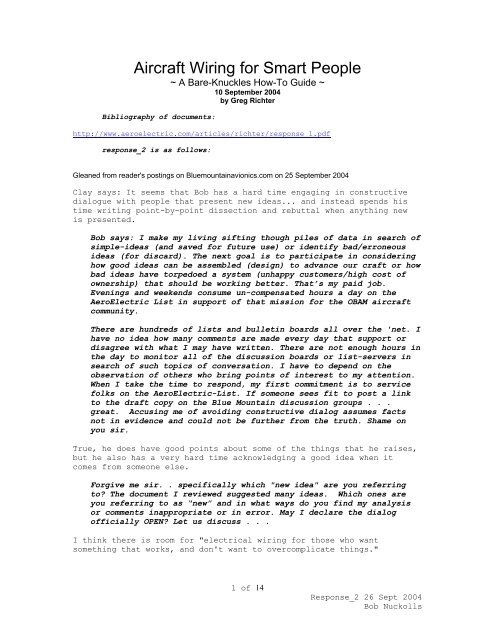
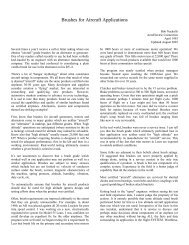
![G-Series-Ext [pdf] - Carling Technologies](https://img.yumpu.com/50918301/1/190x245/g-series-ext-pdf-carling-technologies.jpg?quality=85)
